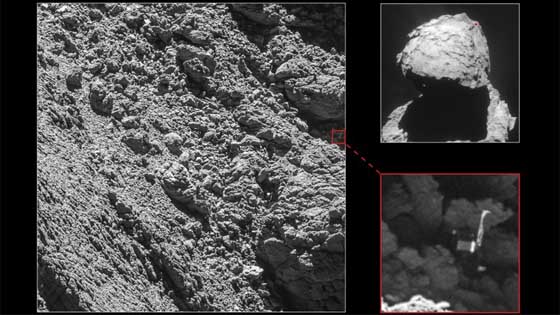European Space Agency’s lost Philae lander has been found; wedged into crack on its comet
Poor fucking Philae. Out there in space, on Comet 67P/Churyumov-Gerasimenko. Wedged into a crack, lost, lost, lost. But now, found! By the space probe Rosetta!
The European Space Agency lost contact with its Rosetta mission’s plucky little lander, Philae, in May 2015. Now the orbiter’s high-resolution camerahas found Philae wedged into a dark crack on the surface of Comet 67P/Churyumov-Gerasimenko.
Landing a small craft on a moving comet was always an incredibly ambitious mission, but the Rosetta team pulled it off in November 2014, with a few hiccups that ultimately resulted in losing contact with Philae. As Gizmodo’s Maddie Stone reported in January:
When the lander touched down in November of 2014, it bounced twice, and wound up in the dark shadow of a cliff. Without enough sunlight to charge its solar panels, Philae quickly exhausted its power supply. Within 57 hours, it had fallen silent.
Six months later, as Comet 67P approached the sun, Philae briefly woke from its slumber and phoned home. Then, it went quiet again. The DLR’s Philae team hasn’t heard a peep since.
Rosetta’s scientists could only narrow the range of Philae’s final resting place based on radio ranging data from its final transmissions. But while they found a few possible locations, the images were not of sufficiently high resolution to confirm with confidence that the lander had been found.
On September 2, Rosetta’s orbit passed sufficiently closet the comet’s surface for its Osiris narrow-angle camera to capture a high-resolution image of the lander’s body and two of its three legs
As Comet 67P/C-G heads away from the sun and towards the orbit of Jupiter, there will be less and less solar energy available to power Rosetta and its instruments. So mission planners will crash the probe into the comet in a slow, controlled descent on September 30th. All the while, Rosetta’s instruments will be feverishly collecting and transmitting data, hopefully giving up some spectacular close-up shots of this extraordinary comet.




